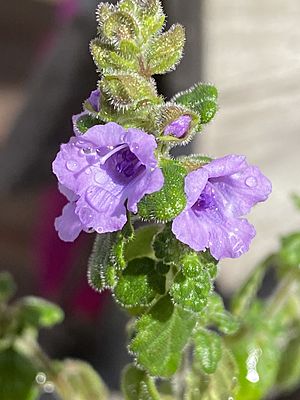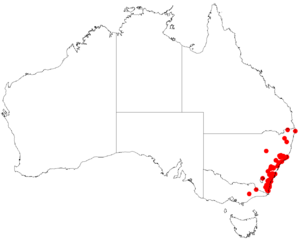Velvet mint-bush facts for kids
Quick facts for kids Velvet mint-bush |
|
|---|---|
 |
|
| Cultivated specimen | |
| Scientific classification | |
| Genus: |
Prostanthera
|
| Species: |
incana
|
 |
|
| Occurrence data from AVH | |
The Velvet mint-bush (Prostanthera incana) is a beautiful flowering plant. It belongs to the mint family, called Lamiaceae. This plant grows naturally only in south-eastern Australia. It's a shrub that stands upright and has many branches. You can spot its egg-shaped leaves and pretty lilac-coloured flowers. It mostly grows near the coast in southern New South Wales.
Contents
What Does the Velvet Mint-Bush Look Like?
The Velvet mint-bush is an upright shrub. It usually grows about 1 to 2.5 meters (3 to 8 feet) tall. Its small branches are covered in fine hairs.
Leaves and Stems
The leaves of this plant are also hairy. They are a dull green color on top. The underside of the leaves is a lighter shade. Each leaf is shaped like an egg and has wavy edges. They are about 9 to 18 millimeters long and 6 to 13 millimeters wide. A short stalk, called a petiole, holds each leaf to the stem.
Flowers
The flowers grow in groups near the ends of the branches. Small leaf-like parts, called bracteoles, are found at the base of the flowers. The green outer parts of the flower, called sepals, are 4 to 6 millimeters long. They form a small tube with two parts at the top. The petals are a lovely lilac color. Each petal is about 8 to 10 millimeters long. The Velvet mint-bush usually blooms from August to December.
Where Does the Velvet Mint-Bush Grow?
The Velvet mint-bush lives in forests and woodlands. It prefers shallow, sandy soil. You can find it along the coast of New South Wales. It grows south from a place called Craven in the Hunter Valley. There is also a small group of these plants in Victoria, near Dargo.
How Was the Velvet Mint-Bush Named?
The Velvet mint-bush was first officially described in 1834. A botanist named George Bentham published its description. He used notes from another botanist, Allan Cunningham. The plant samples used for this description were collected by Charles Fraser in the Blue Mountains. Allan Cunningham also collected samples near where the Nepean and Warragamba Rivers meet.

